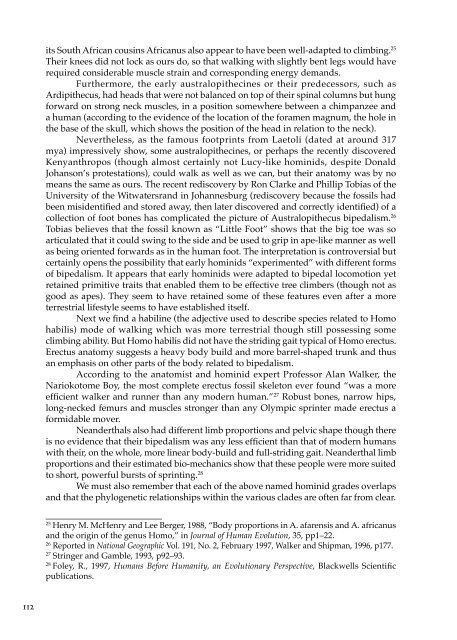The Spirit in Human Evolution - Waldorf Research Institute
The Spirit in Human Evolution - Waldorf Research Institute
The Spirit in Human Evolution - Waldorf Research Institute
You also want an ePaper? Increase the reach of your titles
YUMPU automatically turns print PDFs into web optimized ePapers that Google loves.
its South African cous<strong>in</strong>s Africanus also appear to have been well-adapted to climb<strong>in</strong>g. 25<br />
<strong>The</strong>ir knees did not lock as ours do, so that walk<strong>in</strong>g with slightly bent legs would have<br />
required considerable muscle stra<strong>in</strong> and correspond<strong>in</strong>g energy demands.<br />
Furthermore, the early australopithec<strong>in</strong>es or their predecessors, such as<br />
Ardipithecus, had heads that were not balanced on top of their sp<strong>in</strong>al columns but hung<br />
forward on strong neck muscles, <strong>in</strong> a position somewhere between a chimpanzee and<br />
a human (accord<strong>in</strong>g to the evidence of the location of the foramen magnum, the hole <strong>in</strong><br />
the base of the skull, which shows the position of the head <strong>in</strong> relation to the neck).<br />
Nevertheless, as the famous footpr<strong>in</strong>ts from Laetoli (dated at around 317<br />
mya) impressively show, some australopithec<strong>in</strong>es, or perhaps the recently discovered<br />
Kenyanthropos (though almost certa<strong>in</strong>ly not Lucy-like hom<strong>in</strong>ids, despite Donald<br />
Johanson’s protestations), could walk as well as we can, but their anatomy was by no<br />
means the same as ours. <strong>The</strong> recent rediscovery by Ron Clarke and Phillip Tobias of the<br />
University of the Witwatersrand <strong>in</strong> Johannesburg (rediscovery because the fossils had<br />
been misidentified and stored away, then later discovered and correctly identified) of a<br />
collection of foot bones has complicated the picture of Australopithecus bipedalism. 26<br />
Tobias believes that the fossil known as “Little Foot” shows that the big toe was so<br />
articulated that it could sw<strong>in</strong>g to the side and be used to grip <strong>in</strong> ape-like manner as well<br />
as be<strong>in</strong>g oriented forwards as <strong>in</strong> the human foot. <strong>The</strong> <strong>in</strong>terpretation is controversial but<br />
certa<strong>in</strong>ly opens the possibility that early hom<strong>in</strong>ids “experimented” with different forms<br />
of bipedalism. It appears that early hom<strong>in</strong>ids were adapted to bipedal locomotion yet<br />
reta<strong>in</strong>ed primitive traits that enabled them to be effective tree climbers (though not as<br />
good as apes). <strong>The</strong>y seem to have reta<strong>in</strong>ed some of these features even after a more<br />
terrestrial lifestyle seems to have established itself.<br />
Next we f<strong>in</strong>d a habil<strong>in</strong>e (the adjective used to describe species related to Homo<br />
habilis) mode of walk<strong>in</strong>g which was more terrestrial though still possess<strong>in</strong>g some<br />
climb<strong>in</strong>g ability. But Homo habilis did not have the strid<strong>in</strong>g gait typical of Homo erectus.<br />
Erectus anatomy suggests a heavy body build and more barrel-shaped trunk and thus<br />
an emphasis on other parts of the body related to bipedalism.<br />
Accord<strong>in</strong>g to the anatomist and hom<strong>in</strong>id expert Professor Alan Walker, the<br />
Nariokotome Boy, the most complete erectus fossil skeleton ever found “was a more<br />
efficient walker and runner than any modern human.” 27 Robust bones, narrow hips,<br />
long-necked femurs and muscles stronger than any Olympic spr<strong>in</strong>ter made erectus a<br />
formidable mover.<br />
Neanderthals also had different limb proportions and pelvic shape though there<br />
is no evidence that their bipedalism was any less efficient than that of modern humans<br />
with their, on the whole, more l<strong>in</strong>ear body-build and full-strid<strong>in</strong>g gait. Neanderthal limb<br />
proportions and their estimated bio-mechanics show that these people were more suited<br />
to short, powerful bursts of spr<strong>in</strong>t<strong>in</strong>g. 28<br />
We must also remember that each of the above named hom<strong>in</strong>id grades overlaps<br />
and that the phylogenetic relationships with<strong>in</strong> the various clades are often far from clear.<br />
_________________________<br />
25<br />
Henry M. McHenry and Lee Berger, 1988, “Body proportions <strong>in</strong> A. afarensis and A. africanus<br />
and the orig<strong>in</strong> of the genus Homo,” <strong>in</strong> Journal of <strong>Human</strong> <strong>Evolution</strong>, 35, pp1–22.<br />
26<br />
Reported <strong>in</strong> National Geographic Vol. 191, No. 2, February 1997, Walker and Shipman, 1996, p177.<br />
27<br />
Str<strong>in</strong>ger and Gamble, 1993, p92–93.<br />
28<br />
Foley, R., 1997, <strong>Human</strong>s Before <strong>Human</strong>ity, an <strong>Evolution</strong>ary Perspective, Blackwells Scientific<br />
publications.<br />
112
















